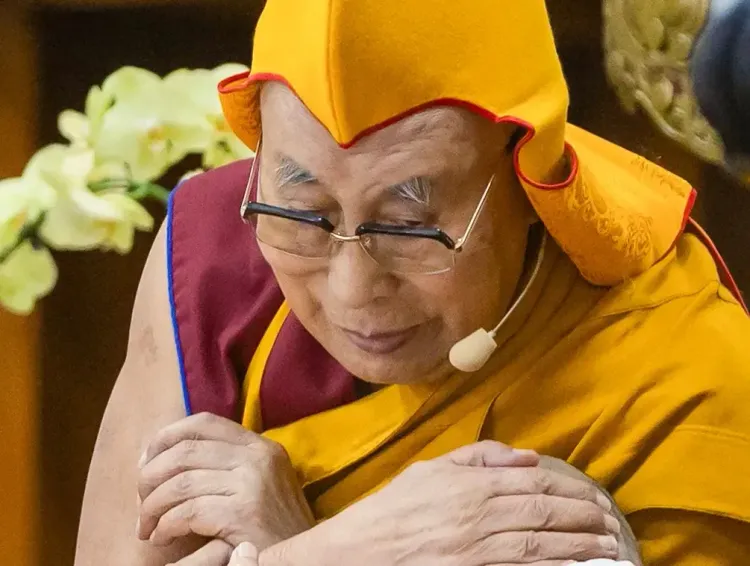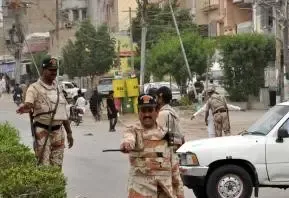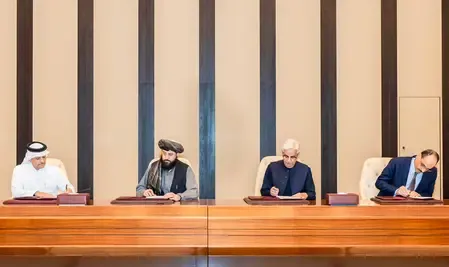Is China Intensifying Its Repressive Campaign Against the Dalai Lama?

Synopsis
Key Takeaways
- Chinese authorities have intensified raids to seize images of the Dalai Lama in Tibet.
- Tibetans face severe repercussions for displaying his photographs.
- State-sanctioned Buddhism is being imposed to undermine the Dalai Lama's influence.
- Coercive measures compel Tibetans to pledge loyalty to the Communist Party.
- Global intervention is crucial to safeguard Tibet's cultural heritage.
Colombo, Nov 7 (NationPress) The Chinese government, increasingly agitated by the rising acclaim of the Dalai Lama and Tibetan Buddhism, has intensified its oppressive religious campaign in Tibet. Recent reports reveal that authorities conducted raids in an Amdo-based monastery and surrounding villages to confiscate images of the Dalai Lama. The Amdo region is home to numerous Tibetan Buddhist monasteries that are of immense cultural and spiritual importance.
For a long time, the Chinese government has prohibited the display of Dalai Lama images in Tibet. Numerous accounts have surfaced of Tibetans being beaten or detained under false pretenses, as reported by Ceylon Wire News. Recently, Chinese officials searched the Larang Tashi Khyil Monastery and nearby villages in Amdo, seizing photographs of the Dalai Lama and asserting that their display was illegal. Officials forcefully entered monks’ quarters and local homes, disrupting all communication in the region. The raids targeted villages such as Thangnag, Ngonchag, Ledruk, and Sangkhog.
Ceylon Wire News reported, "Irritated by the rising popularity of the Dalai Lama and Tibetan Buddhism, the Chinese government has ramped up its oppressive religious campaign in Tibet. Recently, it executed raids in an Amdo monastery and neighboring villages to confiscate photos of the Dalai Lama. The Amdo region is significant for its numerous Tibetan Buddhist monasteries that embody rich cultural and spiritual heritage."
Following searches in residences, officials confiscated photos. In addition to these raids, Chinese authorities compelled Tibetans to partake in a controversial ceremony for the Panchen Lama, organized under heavy security. Monks, nuns, and senior lamas, including the 7th Gunthang Rinpoche, the Sakya abbot, and the Sera abbot were coerced to attend the Kalachakra empowerment led by Gyaltsen Norbu, the state-sanctioned Panchen Lama.
By endorsing Nurbu, the Chinese government is striving to impose its version of Buddhism and diminish the influence of the Dalai Lama. His appointment as the state-recognized Panchen Lama is a crucial element of China’s strategy to manage the religious hierarchy in Tibet, especially in light of the Dalai Lama's eventual succession. The CCP's manipulation of religion arises from its denial of the legitimate 11th Panchen Lama, Gendun Choekyi Nyima, who was abducted by Chinese authorities at age six in 1995 and remains missing.
Four years ago, the Chinese administration initiated a campaign in Zawonpo Township, Sershul County, in the Karze area, where officials removed images of the Dalai Lama and replaced them with pictures of Chinese leaders. Tibetans were coerced into signing a pledge that demanded they express gratitude to the Communist Party, show affection for the motherland, avoid banned images, discourage family members from keeping such pictures, refrain from sharing Dalai Lama images online, and pledge absolute political loyalty. Chinese authorities warned that offenders would lose all state welfare benefits and assistance.
A report from Ceylon Wire News noted, "Freedom House's 2022 Freedom in the World report emphasized that Chinese authorities are 'especially rigorous in suppressing any signs of dissent among Tibetans, including expressions of Tibetan religious beliefs and cultural identity.' This systematic suppression is a part of a broader effort to reshape Tibet's spiritual landscape through state-controlled religion. The CCP's approach to religion is distinct, as faith is only tolerated if it aligns with the Party's objectives. By promoting 'Chinese Buddhism,' Beijing aims to create an illusion of religious harmony while utilizing religion as a political instrument to consolidate control over Tibet. This strategy seeks to erode Tibetan cultural identity and replace it with a unified narrative of Party loyalty disguised as patriotism."
"China's ongoing crackdown on followers of the Dalai Lama and Tibetan Buddhism represents a calculated political maneuver aimed at stifling Tibet's spiritual autonomy. 'Chinese Buddhism' has transformed into a façade and a political weapon wielded by Beijing, intended to suppress centuries-old Tibetan faith and substitute it with a state-approved version of obedience. The international community, particularly the United States and Western democracies, must adopt a firmer stance against China's religious persecution in Tibet. It is crucial to hold Beijing accountable through diplomatic, legal, and human rights channels to prevent the extinction of Tibet's cultural and spiritual identity. Without decisive global intervention, the voice of Tibetan Buddhism and the teachings of the Dalai Lama face the threat of being silenced beneath the weight of authoritarian control," the report concluded.









